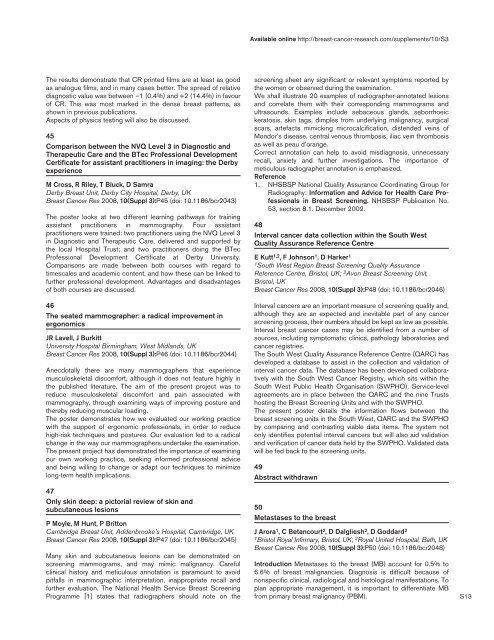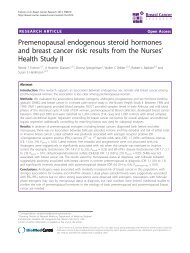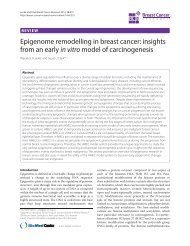Ultrasound-guided axillary node core biopsy - Breast Cancer ...
Ultrasound-guided axillary node core biopsy - Breast Cancer ...
Ultrasound-guided axillary node core biopsy - Breast Cancer ...
You also want an ePaper? Increase the reach of your titles
YUMPU automatically turns print PDFs into web optimized ePapers that Google loves.
Available online http://breast-cancer-research.com/supplements/10/S3<br />
The results demonstrate that CR printed films are at least as good<br />
as analogue films, and in many cases better. The spread of relative<br />
diagnostic value was between –1 (0.4%) and +2 (14.4%) in favour<br />
of CR. This was most marked in the dense breast patterns, as<br />
shown in previous publications.<br />
Aspects of physics testing will also be discussed.<br />
45<br />
Comparison between the NVQ Level 3 in Diagnostic and<br />
Therapeutic Care and the BTec Professional Development<br />
Certificate for assistant practitioners in imaging: the Derby<br />
experience<br />
M Cross, R Riley, T Bluck, D Samra<br />
Derby <strong>Breast</strong> Unit, Derby City Hospital, Derby, UK<br />
<strong>Breast</strong> <strong>Cancer</strong> Res 2008, 10(Suppl 3):P45 (doi: 10.1186/bcr2043)<br />
The poster looks at two different learning pathways for training<br />
assistant practitioners in mammography. Four assistant<br />
practitioners were trained: two practitioners using the NVQ Level 3<br />
in Diagnostic and Therapeutic Care, delivered and supported by<br />
the local Hospital Trust; and two practitioners doing the BTec<br />
Professional Development Certificate at Derby University.<br />
Comparisons are made between both courses with regard to<br />
timescales and academic content, and how these can be linked to<br />
further professional development. Advantages and disadvantages<br />
of both courses are discussed.<br />
46<br />
The seated mammographer: a radical improvement in<br />
ergonomics<br />
JR Lavell, J Burkitt<br />
University Hospital Birmingham, West Midlands, UK<br />
<strong>Breast</strong> <strong>Cancer</strong> Res 2008, 10(Suppl 3):P46 (doi: 10.1186/bcr2044)<br />
Anecdotally there are many mammographers that experience<br />
musculoskeletal discomfort, although it does not feature highly in<br />
the published literature. The aim of the present project was to<br />
reduce musculoskeletal discomfort and pain associated with<br />
mammography, through examining ways of improving posture and<br />
thereby reducing muscular loading.<br />
The poster demonstrates how we evaluated our working practice<br />
with the support of ergonomic professionals, in order to reduce<br />
high-risk techniques and postures. Our evaluation led to a radical<br />
change in the way our mammographers undertake the examination.<br />
The present project has demonstrated the importance of examining<br />
our own working practice, seeking informed professional advice<br />
and being willing to change or adapt our techniques to minimize<br />
long-term health implications.<br />
47<br />
Only skin deep: a pictorial review of skin and<br />
subcutaneous lesions<br />
P Moyle, M Hunt, P Britton<br />
Cambridge <strong>Breast</strong> Unit, Addenbrooke’s Hospital, Cambridge, UK<br />
<strong>Breast</strong> <strong>Cancer</strong> Res 2008, 10(Suppl 3):P47 (doi: 10.1186/bcr2045)<br />
Many skin and subcutaneous lesions can be demonstrated on<br />
screening mammograms, and may mimic malignancy. Careful<br />
clinical history and meticulous annotation is paramount to avoid<br />
pitfalls in mammographic interpretation, inappropriate recall and<br />
further evaluation. The National Health Service <strong>Breast</strong> Screening<br />
Programme [1] states that radiographers should note on the<br />
screening sheet any significant or relevant symptoms reported by<br />
the women or observed during the examination.<br />
We shall illustrate 20 examples of radiographer-annotated lesions<br />
and correlate them with their corresponding mammograms and<br />
ultrasounds. Examples include sebaceous glands, seborrhoeic<br />
keratosis, skin tags, dimples from underlying malignancy, surgical<br />
scars, artefacts mimicking microcalcification, distended veins of<br />
Mondor’s disease, central venous thrombosis, iliac vein thrombosis<br />
as well as peau d’orange.<br />
Correct annotation can help to avoid misdiagnosis, unnecessary<br />
recall, anxiety and further investigations. The importance of<br />
meticulous radiographer annotation is emphasized.<br />
Reference<br />
1. NHSBSP National Quality Assurance Coordinating Group for<br />
Radiography: Information and Advice for Health Care Professionals<br />
in <strong>Breast</strong> Screening. NHSBSP Publication No.<br />
53, section 8.1. December 2002.<br />
48<br />
Interval cancer data collection within the South West<br />
Quality Assurance Reference Centre<br />
E Kutt 1,2 , F Johnson 1 , D Harker 1<br />
1 South West Region <strong>Breast</strong> Screening Quality Assurance<br />
Reference Centre, Bristol, UK; 2 Avon <strong>Breast</strong> Screening Unit,<br />
Bristol, UK<br />
<strong>Breast</strong> <strong>Cancer</strong> Res 2008, 10(Suppl 3):P48 (doi: 10.1186/bcr2046)<br />
Interval cancers are an important measure of screening quality and,<br />
although they are an expected and inevitable part of any cancer<br />
screening process, their numbers should be kept as low as possible.<br />
Interval breast cancer cases may be identified from a number of<br />
sources, including symptomatic clinics, pathology laboratories and<br />
cancer registries.<br />
The South West Quality Assurance Reference Centre (QARC) has<br />
developed a database to assist in the collection and validation of<br />
interval cancer data. The database has been developed collaboratively<br />
with the South West <strong>Cancer</strong> Registry, which sits within the<br />
South West Public Health Organisation (SWPHO). Service-level<br />
agreements are in place between the QARC and the nine Trusts<br />
hosting the <strong>Breast</strong> Screening Units and with the SWPHO.<br />
The present poster details the information flows between the<br />
breast screening units in the South West, QARC and the SWPHO<br />
by comparing and contrasting viable data items. The system not<br />
only identifies potential interval cancers but will also aid validation<br />
and verification of cancer data held by the SWPHO. Validated data<br />
will be fed back to the screening units.<br />
49<br />
Abstract withdrawn<br />
50<br />
Metastases to the breast<br />
J Arora 1 , C Betancourt 2 , D Dalgliesh 2 , D Goddard 2<br />
1 Bristol Royal Infirmary, Bristol, UK; 2 Royal United Hospital, Bath, UK<br />
<strong>Breast</strong> <strong>Cancer</strong> Res 2008, 10(Suppl 3):P50 (doi: 10.1186/bcr2048)<br />
Introduction Metastases to the breast (MB) account for 0.5% to<br />
6.6% of breast malignancies. Diagnosis is difficult because of<br />
nonspecific clinical, radiological and histological manifestations. To<br />
plan appropriate management, it is important to differentiate MB<br />
from primary breast malignancy (PBM).<br />
S13






